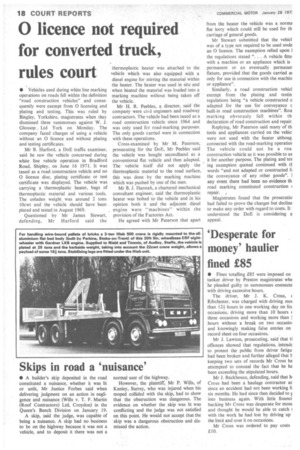0 licence not required for converted truck, rules court
Page 20

If you've noticed an error in this article please click here to report it so we can fix it.
• Vehicles used during white line marking operations on roads fell within the definition "road construction vehicles" and consequently were exempt from 0 licensing and plating and testing. This was ruled by Bingley, Yorkshire, magistrates when they dismissed three summonses against W. J. Glossop , Ltd York on Monday. The company faced charges of using a vehicle without an 0 licence and without plating and testing certificates.
Mr B. Harford, a DoE traffic examiner, said he saw the vehicle concerned during white line vehicle operation in Bradford Road, Shipley, on June 16 1971. It was taxed as a road construction vehicle and no 0 licence disc, plating certificate or test certificate was displayed. The vehicle was carrying a thermoplastic heater, bags of thermoplastic material and various tools. The unladen weight was around 2 tons lOcwt and the vehicle should have been plated and tested in August 1969.
Questioned by Mr James Stewart, defending, Mr Harford said the thermoplastic heater was attached to the vehicle which was also equipped with a diesel engine for stirring the material within the heater. The heater was used in situ and when heated the material was loaded into a marking machine without being taken off the vehicle.
Mr H. R. Peebles, a director, said the company were civil engineers and roadway contractors. The vehicle had been taxed as a road construction vehicle since 1964 and was only used for road-marking purposes. The only goods carried were in connection with these operations.
Cross-examined by Mr M. Paterson, prosecuting for the DoE, Mr Peebles said the vehicle was bought secondhand as a conventional flat vehicle and then adapted. The vehicle itself did not apply the thermoplastic material to the road surface, this was done by the marking machine which was pushed by one of the men.
Mr B. J. Hannah, a chartered mechanical consultant engineer, said the thermoplastic heater was bolted to the vehicle and in his opinion both it and the adjacent diesel engine were "machines" within the provision of the Factories Act.
He agreed with Mr Paterson that apart from the heater the vehicle was a norma flat lorry which could still be used for th carriage of general goods.
Mr Stewart submitted that the vehicl was of a type not required to be used unde an 0 licence. The exemption relied upon i the regulations stated ". . . A vehicle fitte with a machine or an appliance which is permanent or an eventually permanen fixture, provided that the goods carried ai only for use in connection with the machin or appliance".
Similarly, a road construction vehicl exempt from the plating and testin regulations being "a vehicle constructed o adapted for the use for conveyance c built-in road construction machines". Roa marking obviously fell within th declaration of road construction and repair.
Replying, Mr Paterson said many of th tools and appliances carried on the vehic: were not used with the heater althoug connected with the road-marking operatior The vehicle could not be a roa, construction vehicle as it was possible to us it for another purpose. The plating and tes ing exemption quoted continued with ti words "and not adapted or constructed ft the conveyance of any other goods". 1 any event there had been no evidence th road marking constituted construction ( repair. ,
Magistrates found that the prosecutio had failed to prove the charges but decline to make any order with regard to costs. It: understood the DoE is considering a appeal.
























































































